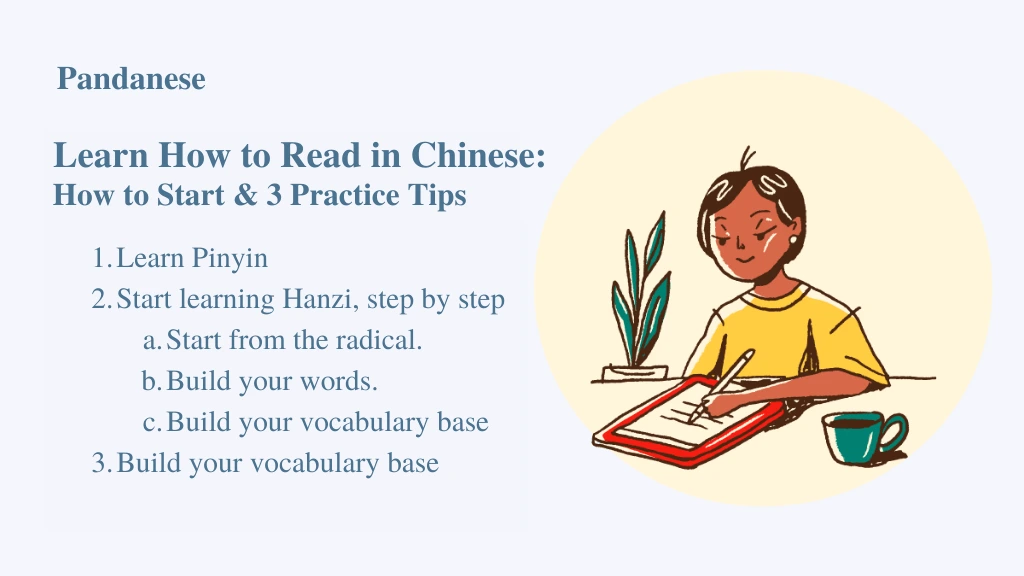
How to Read in Chinese: How to Start & 3 Practice Tips
Looking at the Chinese writing system can look intimidating. And reading Mandarin Chinese is a whole other level.
Any Chinese learners want to know how to read Chinese. While we look up every word in the dictionary, when it comes to reading paragraphs and sentences, using the dictionary will take too much time and effort.
The only way to read in Chinese fluently is through exposure and learning. Our brain can be the best dictionary there is for us. You can make your brain a powerful Chinese dictionary with the right approach.
While everyone's learning style is different, it's better to understand the components of the Mandarin Chinese language. You can take a look at these articles to help you out 🙂.
Is learning Mandarin hard?
Starting to learn Mandarin can be hard, but with dedication and practice, it is possible to become fluent in it.
The Chinese language uses thousands of individual characters that must be memorized and uses tones different from English.
Also, Mandarin grammar rules differ from English ones, making for an even steeper learning curve.
Despite all these difficulties, there are plenty of physical and online Chinese resources to help students learn Mandarin successfully.
How do I start reading Chinese?
1. Learn Pinyin
The best way to start reading Chinese tones is to use 拼音, or pīn yīn, which means "combine sounds." Pinyin is the romanized version of Chinese characters, allowing those familiar with the Latin alphabet to read and pronounce Chinese.
You can think of pinyin as simpler characters as they are the components that make up Chinese characters.
So with pinyin, you'll be able to read in Chinese using these roman letters as a guide to pronounce Chinese words correctly and to distinguish between one word and another. Additionally, writing or typing in pinyin is much easier with roman letters from an english speaking country.
2. Start learning Hanzi, step by step
After learning the basics of pinyin, you can start learning Hanzi step by step.
Learning Chinese characters or hanzi can be difficult as some will have multiple stroke orders or look alike.
a. Start from the radical.
A radical is an element of a Chinese character.
Radicals can help you broadly categorize the words based on the radicals the words are made of. Take, for example, the radical mouth.

An example of Pandanese's mouth character flashcard
Words that contain the radical mouth can be connected with speaking, the mouth, or words.
Another example would be the radical 氵 as it can be seen in characters such as sweat 汗 and warm 温.
Knowing the radical will help you familiarize yourself with each character component.
b. Build your words.
Chinese words comprise one or multiple radicals to form a character. Take, for example, the word card below.

Let's break down this Chinese character
This hanzi is 如 (rú) and combines the woman and mouth radical. To better understand this word, we can use mnemonics to help us understand and memorize 如 better.
A mnemonic for 如 (rú) can be:
"Since you were young, your dad has been giving you advice about women like, "Rupert (rú), if you read books, girls will like you." However, that wasn't always the case. It was just a simple ruse to get you to read."
To help remember this word, you can try the following:
"IF you listen to everything that comes out of your WOMAN's (女) MOUTH (口), you'll live a happy life, your dad said to you when you were 10."
3. Build your vocabulary base
After learning the words, you can combine some of those words and start building your vocabulary base. Let's use the Chinese word 不如 (bù rú) as an example. The first character is the Chinese radical for wasp, and the second character is 如 (rú).

Pandanese’s vocabulary 不如 flashcard
Knowing both contexts, 不如 (bù rú) means not equal to. The word 不 (bù) means "don't" or "not," and 如 (rú) means if.
By combining these two characters together, the meaning becomes "not equal to" or implies the meaning no better than.
3 ways to practice how to read in Chinese
1. Review your vocabulary.
To help with long-term memory, it's best to keep reviewing familiar characters and build your vocabulary and Chinese grammar.
As you continue practicing, reading Chinese texts will become easier as you can differentiate and interpret the Chinese characters' meanings.
2. Read aloud Chinese texts.
Additionally, reading aloud helps build vocabulary as it makes you slow down and allows your brain to process each word. So read aloud or whisper all the characters that you are seeing. Plus, it helps with your pronunciation.
3. Write sentences.
Writing example sentences will not only help build your vocabulary but will also strengthen your vocabulary and grammar.
Frequently asked questions
How do you read Chinese?
To read Chinese, you need to understand the basics, such as pinyin, and to be able to recognize Chinese characters. From there, you can start building your Chinese vocabulary and grammar points to then start to read Chinese sentences through context and meaning. With enough practice, you can read Chinese confidently.
In closing
To read in Chinese fluently, you need to understand the context and nuisance of the Chinese language. By putting in effect to build upon the basic Chinese foundations, you will be able to connect and understand the Chinese language.
By learning the characters from radical, to words, to vocabulary, you will build your Chinese reading skills strongly.
The easiest way to learn Chinese & build vocabulary

